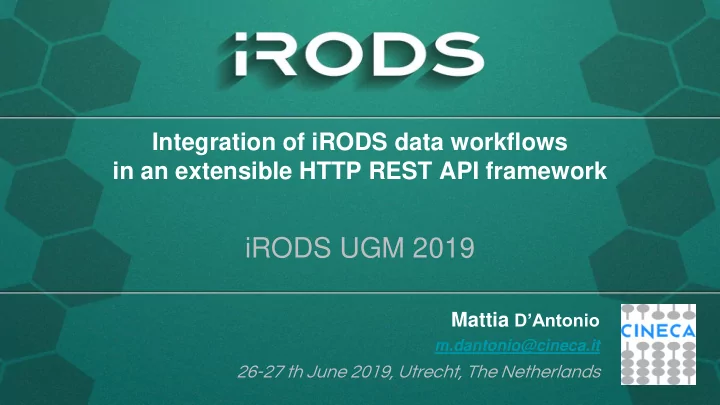

Integration of iRODS data workflows in an extensible HTTP REST API framework iRODS UGM 2019 Mattia D’Antonio m.dantonio@cineca.it 26-27 th June 2019, Utrecht, The Netherlands
Key points ● CINECA is involved in many European projects and National initiatives ● My group in particular is committed in Data Management ● Every project has is own very specific requirements but some common needs can be identified ● We are building a common layer among all these projects ● iRODS is the base data technology adopted onto these projects 2
Common projects requirements 3
EUDAT CDI EUDAT Collaborative Data Infrastructure (CDI) is a network of nodes that provide a range of services for data upload, retrieval, identification, replication. The nodes are essentially data centers EUDAT supports several services but I will focus on two core services: B2SAFE – data and policy management service build over iRODS B2STAGE – HTTP API interface for data transfer build over B2SAFE 4
B2STAGE ● HTTP RESTful interface offering functionalities for data transfer between EUDAT resources (B2SAFE =~ iRODS) and external computational facilities HTTP API Nginx proxy Flask server Session database 5
SeaDataCloud ● Pan-European infrastructure for ocean & marine data management ● Data from sensors, ships, platforms are stored in a centralized repository to be standardized, validated, indexed 6
SDC CDI HTTP API Nginx proxy Private Docker Hub HTTP APIs Celery workers Rancher RabbitMQ + MongoDB Quality checks PostgreSQL Ingestion and ordering Heavy data management Execution of data APIs are built on operations = workflows (as docker B2STAGE by adding asynchronous task (with containers orchestrated custom endpoints Celery) through Rancher) 7
Genomic Repository Initiative National initiative for the implementation of a Genomic Repository, in collaboration with: Telethon Foundation ○ ■ a non-profit organization for genetic diseases research SIGU ○ ■ Italian Society for Human Genomics 8
Genomic Repository A platform on which a researcher can: ● Deposit sequencing data ● Manage metadata and annotations ● Create correlations between datasets ● Perform HPC analyses on archived data to produce more information 9
Common requirements among the 3 use cases ● Data storing ● Metadata management ● Access via REST API ● Execution of asynchronous operations ● Access from HPC cluster or other workflow manager We created a common framework (named RAPyDO) to share solutions among these projects 10
RAPyDO ● RAPyDO: Rest Apis with Python on Docker ● Implements a set of HTTP REST APIs (integrated with several services) to support users of different communities to implement data workflows and services ● APIs include the integration with iRODS ● Built as a wrapper of docker-compose for easy deployment on every platform ● RAPyDO is an extensible and modular framework used as a base for the projects 11
Architecture stack Nginx proxy Flask server ( HTTP APIs ) Core endpoints projects endpoints Resources Custom projects resources Session database RAPyDO controller Docker-compose Docker 12
iRODS integration ● HTTP APIs are written in Python by using the Flask framework ● A wrapper client based on the python-irods-client implements common operations ● The client is used from both API endpoints and celery tasks to easily interact with iRODS def get(self, collection): if self.irods.exists(collection): return self.irods.list( collection, recursive=True, acl=True) 13
Implemented methods ● Methods mapped on icommands ○ e.g. list(), mkdir(), put(), get(), move(), remove(), set_permissions(), ticket(), etc ○ mapped on ils, imkdir, iput, iget, imv, irm, ichmod, iticket, etc ● Simple utilities methods without a corresponding icommand ○ e.g. exists(), is_collection(), is_dataobject() and others ● Method to perform more complex operations, e.g. ○ Methods to read and write file content as strings, chunks or Flask data streams 14
Authentication ● HTTP APIs support all iRODS authentication protocols: ○ Native credentials ○ Pluggable authentication modules (PAM) ○ Grid Security Infrastructure (GSI) Native credentials are natively supported by python-irods-client 15
PAM and GSI modules We contributed to the PRC by developing authentication modules for: ● Grid Security Infrastructure (GSI) ○ Merged on main branch on Jan 2017 ○ Status: completed ● Pluggable authentication modules (PAM) ○ Merged on main branch on Dec 2018 ○ Status: partially completed, some issues to be fixed ■ e.g. #156 PAM authentication and irods_environment.json 16
Asynchronous operations ● Some operations are (quite) fast and can be execute synchronously ● To be able to execute data intensive and complex workflows we also introduced an asynchronous layer ● Implemented on Celery, a task management queue based on distributed message passing. 17
High Performance Computing ● Many projects need to store data for archiving purpose to be treated as read-only resources (e.g. for data search / retrieval) ● Other projects use archived data as inputs for analyes ● The use of iRODS ensure data to be easily shared beetwen all the components ● The use of ACL ensure data security by preserving access rights 18
Complete workflow 19
Dockerized environments ● HPC clusters are not always the solution ● More flexibility can be achieved through docker ● Docker containers can be orchestrated by using services like Rancher ● We implemented a Rancher client integrated into RAPyDO 20
iRODS main benefits ● Stability and scalability, also for big data projects ● Accessibility from different locations (REST APIs, HPC cluster) ● Security and access policies (preserved regardless the access method) ● Many authentication methods (some of our projects are certificates-based, other are defined on LDAP servers -> GSI, PAM) ● Data replication ● Rules 21
Conclusions ● iRODS is the perfect technology as base for many data-oriented projects ● Projects need higher-level services to be built over it ● Common requirements can be translate in common solutions Don’t reinvent the wheel… ○ ● Risk of fossilization on obsolete solutions ○ Every new project can start from previous solutions … and perfect it ○ Don’t reinvent, perfect it 22
Thank you for your attention Mattia D’Antonio – m.dantonio@cineca.it https://github.com/rapydo 24
Recommend
More recommend